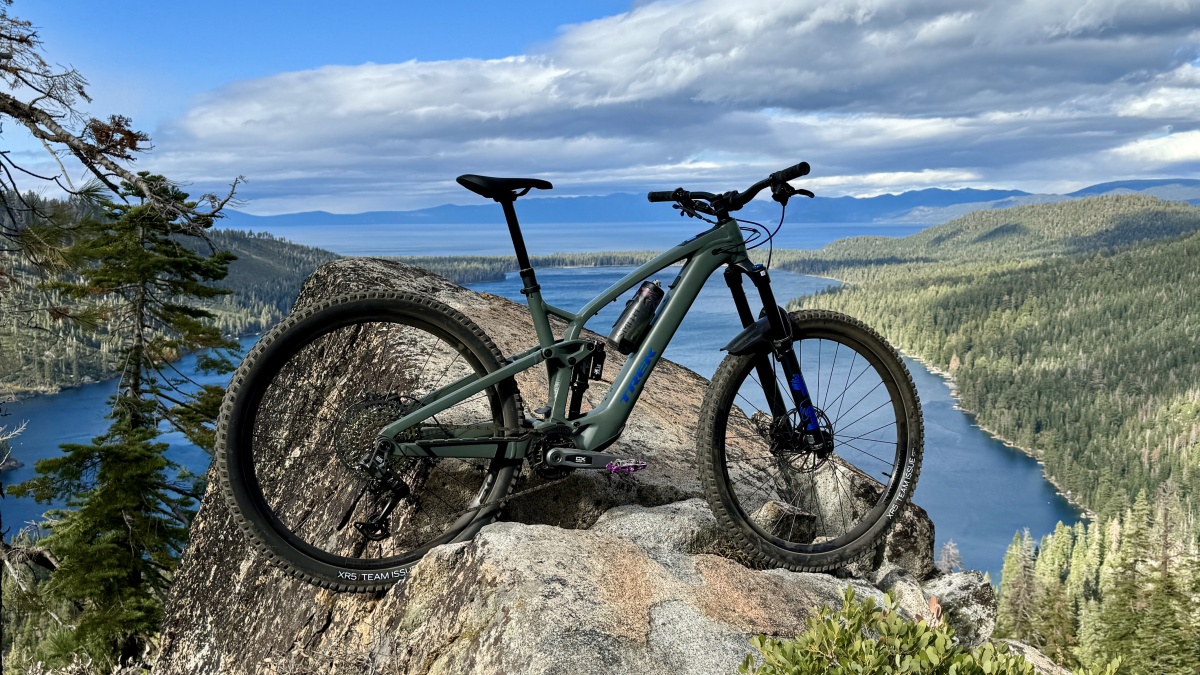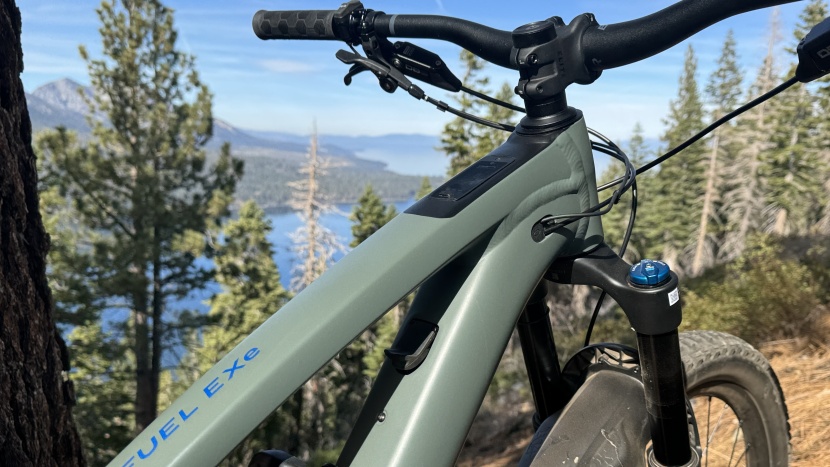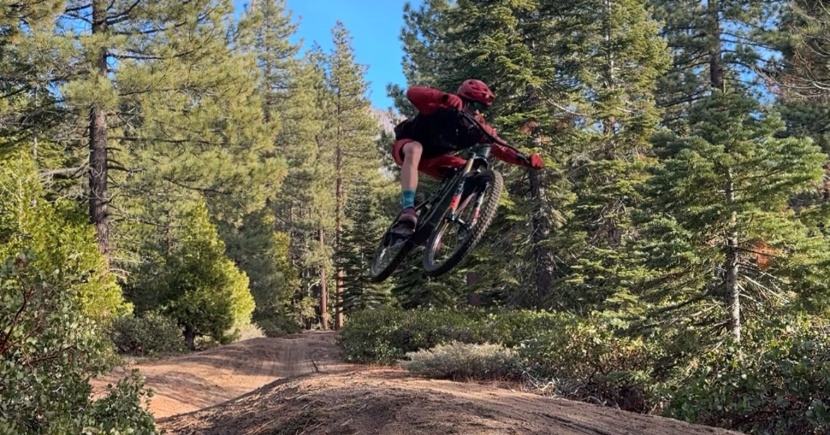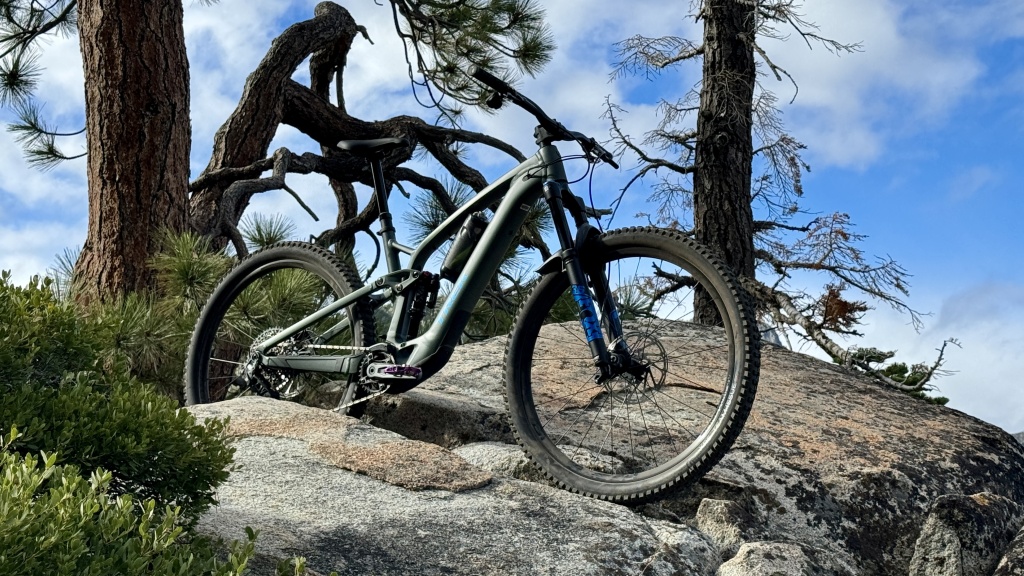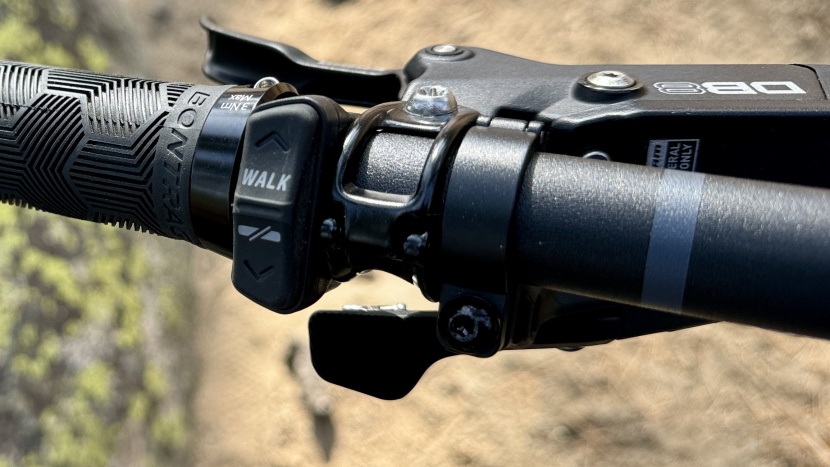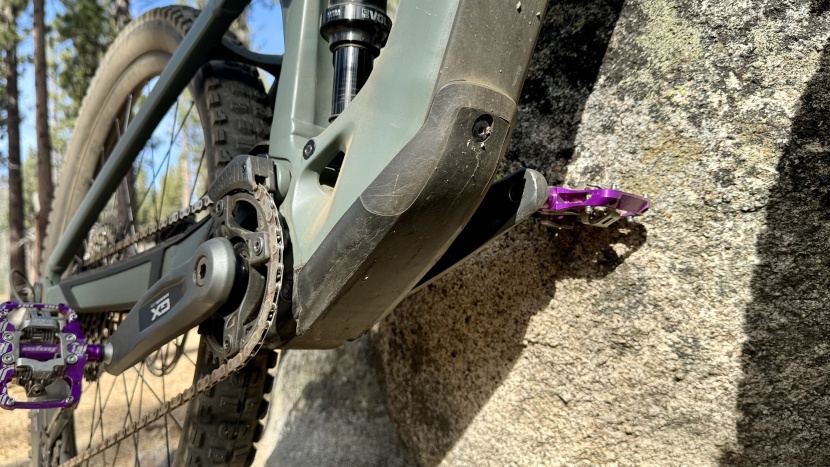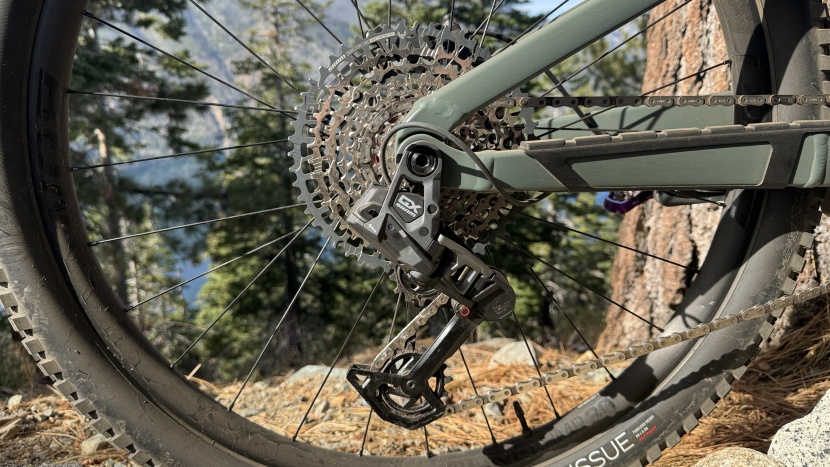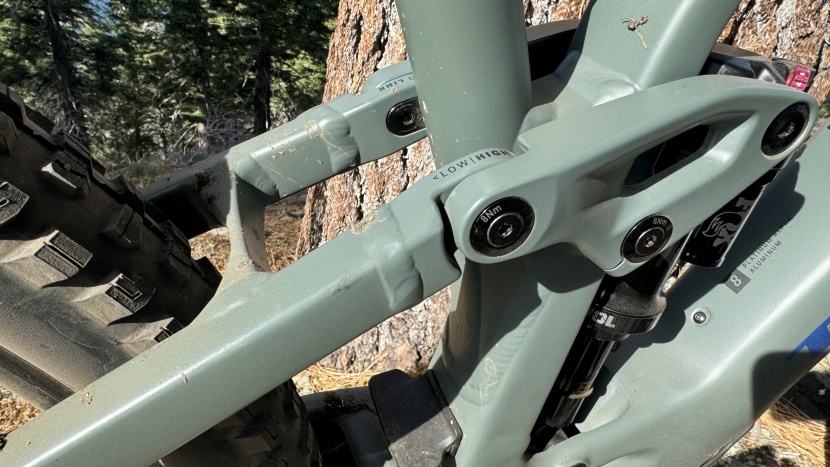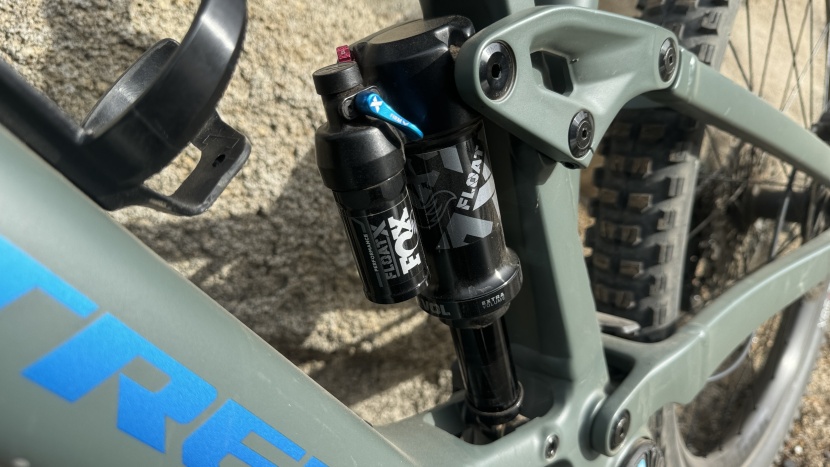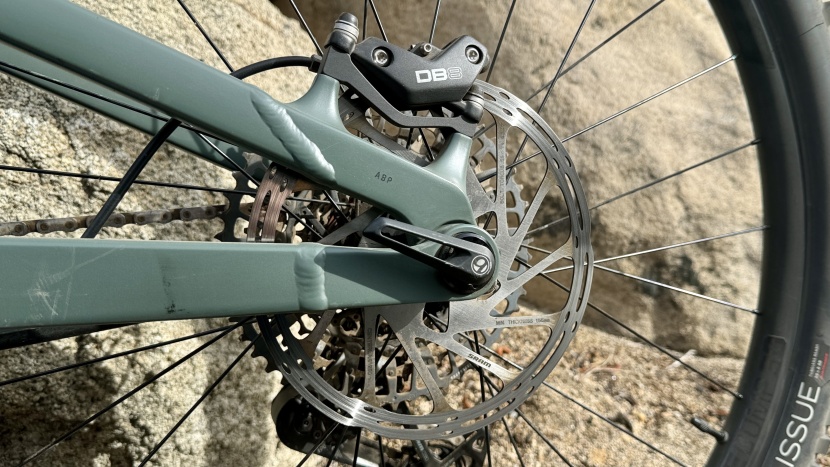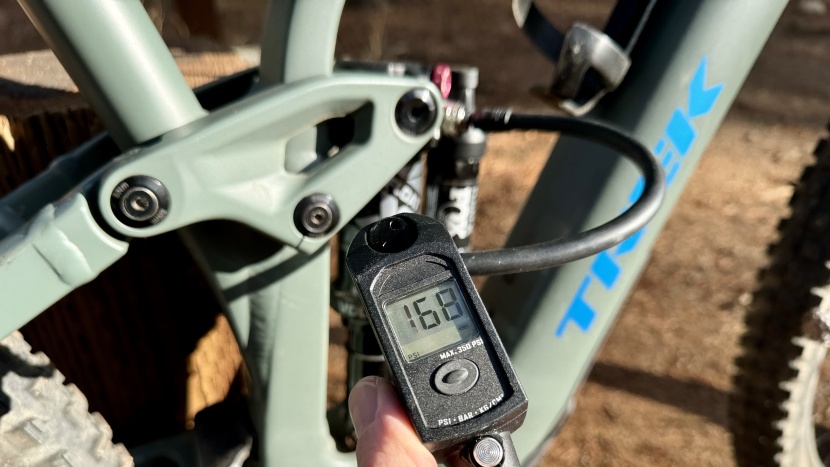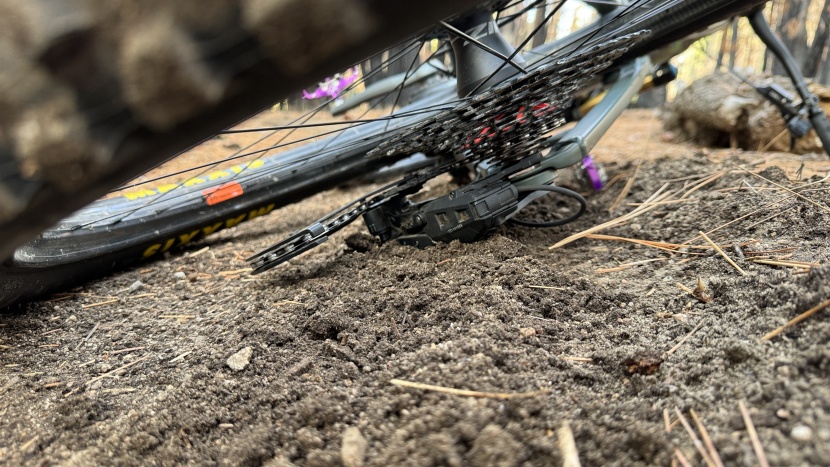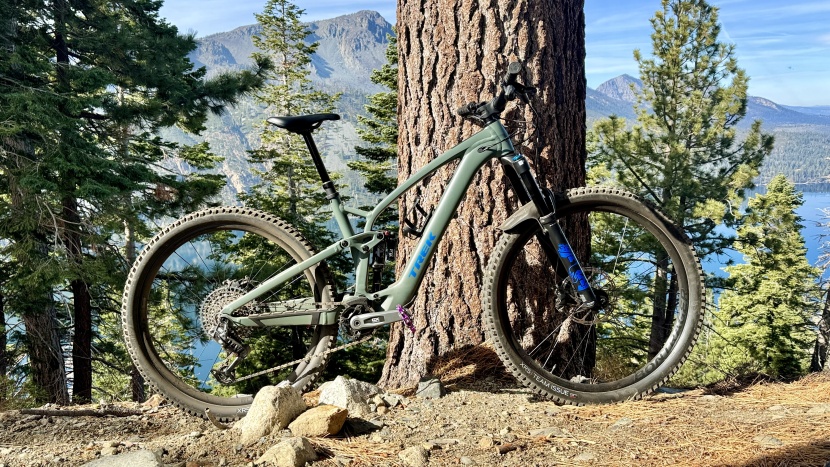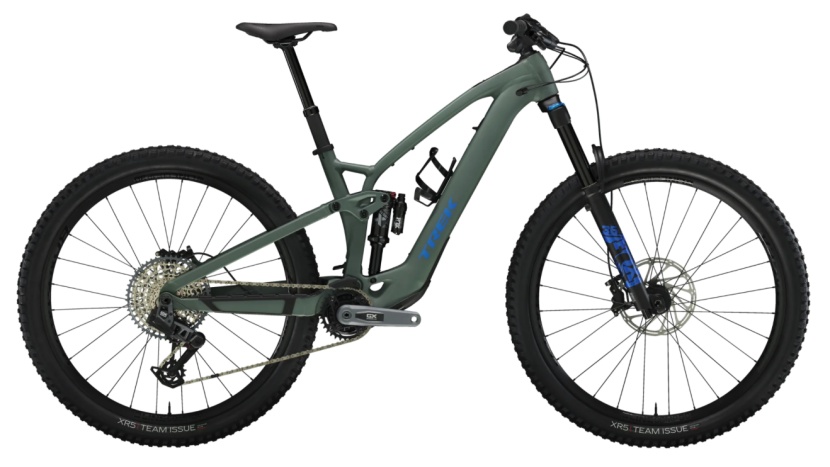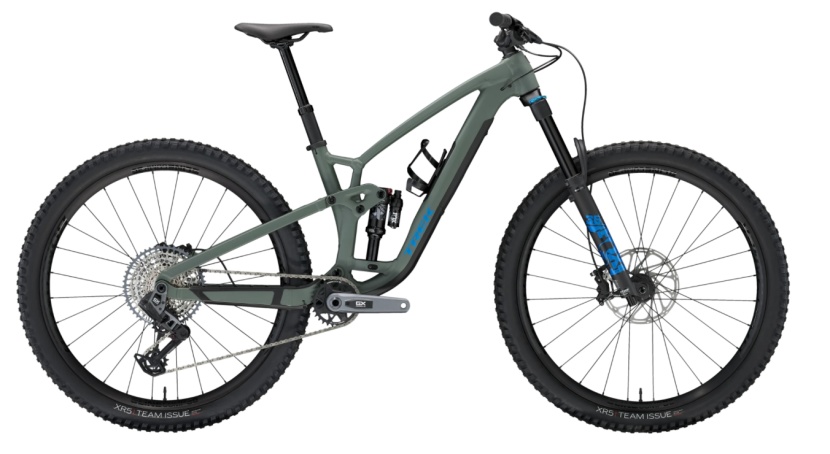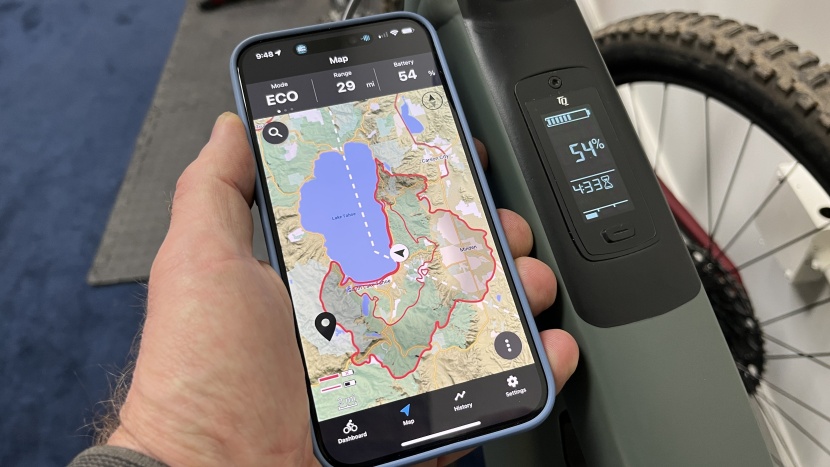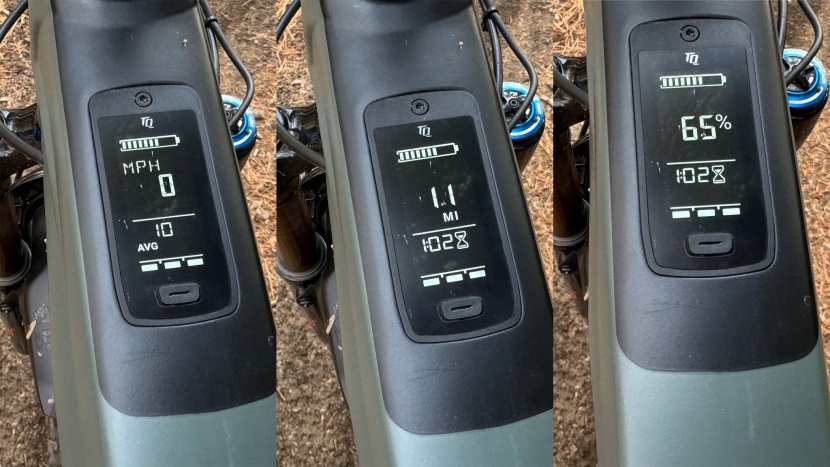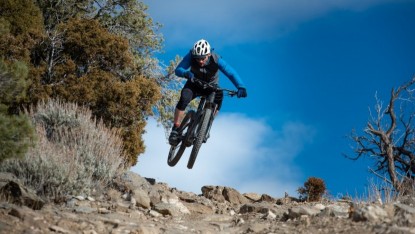
Our Verdict
Our Analysis and Test Results
There's no doubt that Trek is at the forefront of bicycle innovation, and products like this prove it. Trek partnered with TQ to bring the Harmonic Pin Ring Drive unit to their trail bikes. The motor is smaller and lighter than a traditional e-bike motor, with significantly fewer moving parts. That put very few restrictions on how Trek could implement the suspension. We loved the new Gen 6 Fuel, and the EXe is essentially the powered version of that bike. Almost everything we loved about the new Fuel's geometry, Mino-link, and ABP suspension carries over to this bike. The downtube now houses a removable 360Wh battery pack. The tiny but mighty TQ motor sits inconspicuously in place of a bottom bracket, producing 50 Nm of torque. The technology integrates seamlessly; the EXe is a full-fledged trail bike that just happens to be powered. Read on for our full thoughts on this carbon-free bike; it's much more than the numbers suggest.
Design Highlights
- Available in OCLV carbon fiber and aluminum frames, S, M, L, and XL sizes.
- TQ-HPR50 motor provides 50 Nm of torque, 250-watt nominal power, 300-watt peak power
- 29-inch wheels on all models (Mullet-compatible)
- 140mm ABP (Active Braking Pivot) suspension / 150mm Fox Rhythm fork
- Adjustable geometry with Mino-Link and swappable head cups (not included)
- 360Wh removable battery pack
- Room for large shocks and long dropper posts
Frame Design
The Trek Fuel EXe has been designed around the motor and battery, but those components are so small that Trek didn't have to make many compromises to power up the Fuel. Travel on this bike is 140mm using Trek's signature Active Braking Pivot (ABP) suspension design. ABP uses a four-bar configuration, with the primary pivot mounted just above the bottom bracket and midway up the seat tube, a rocker link connected to a vertically oriented shock. What sets ABP apart from other designs is that its rear pivot is located around the rear axle, allowing for freer suspension movement when you're on the brakes. The bottom of the shock mounts to a span between the down and seat tubes. The EXe doesn't look like an e-bike; its downtube hides a removable 360Wh battery pack and all of the bike's cables. In place of the bottom bracket is the tiny but mighty TQ-HPR50 that generates 50Nm of torque and is significantly smaller than a traditional e-bike motor. Battery and motor aside, it's a true modern trail bike with Trek's current Fuel geometry; that's a good thing! This bike features angle-adjust headset cups (available separately), giving riders choices in half-degree increments between 63.8 and 66.3 degrees when factoring in the Mino-links adjustability. The Mino-link slackens the head and seat tube angles by a half degree while dropping the bottom bracket by 7mm. The seat tube hovers around 77 degrees, keeping you directly over the drivetrain on all but the steepest climbs.
Downhill Performance
The Fuel EXe feels solid and planted; how much this bike rode like its analog cousin was remarkable. The bike has enough bravado to charge the hard lines but can still be finessed creatively. When descending, the bike's mass becomes a mostly positive attribute; the ABP suspension feels even more adept at keeping the rear wheel engaged. It feels much more like a regular trail bike than a full-powered e-bike. It feels playful, and the downhill experience isn't dominated by the fact it's an e-bike. In certain situations, the bike can still feel heavy, its helpful acceleration is elusive above 20 mph. The bike comes off the ground with little resistance, but throwing it around the jump line, you can be surprised by its sudden mass.
The bike pops out of the corners with its lively and natural feeling acceleration. In flowy sections of trail, you don't notice the motor powering in and out; it's just a feeling of riding faster than you normally do with a similar cardio output. In many ways, the motor disappears from your experience descending; the bits of assistance you get are easily mistaken for fitness. The Rhythm fork doesn't offer much adjustability, but its factory dampening caused no complaints. The Fox Performance Float X provides the cush for the rear end and is also a little shy on adjustability, featuring only an open/firm lever and adjustable rebound dampening. The Bontrager XR5 tires have some ground-hugging chops that help this bike change directions rapidly, but they lack the heroic cornering traction of the Bontrager SE5 we tested on the newest Fuel.
The geometry borrows heavily from the analog Fuels modern trail bike dimensions. The EXe doesn't get the size-specific chainstays or a flip-chip but retains most of its analog counterpart's dimensions and general feel. We rode this bike with several head tube settings, played with the Mino-link, and added a 160mm fork. The sweet spot of its performance was with geometry at 64.8 / 76.8, the Mino-link in low, and the 150mm fork. The 160mm fork gave the bike a little more courage, but it lost a bit of its pep and playfulness. With the Mino-Link in high, you can run this bike with a 27.5" rear wheel for the mullet effect, but your cutoff speed will be lower due to the small circumference wheel; there is currently no way to adjust the computer for a different wheel size. This bike gets a ton of downhill stability from the 1247mm wheelbase but its 440mm stays let it manual with ease. The reach on our size Large test model was 483mm, giving the rider plenty of room to move around or stare at the top tube display.
Beyond geometry and suspension, the downhill performance of this bike is supported by Avid DB8 brakes. These are the first Avid brakes to use mineral oil, and they're quite effective in clamping down on the 200mm rotors. The 170mm dropper post gets the saddle out of the way, and the rest of the cockpit is a comfortable selection of Bontrager goods that work well enough. A carbon handlebar would have increased our downhill comfort and is probably something we'll add if this bike ends up in long-term testing.
Climbing Performance
This bike just flattens the climbs; a rip on this bike is reminiscent of race day legs when you show up at the start gate with months of training pulsing through your muscles, your heart rate is up from excitement rather than exertion, and you're caught reacting to how insanely fast you're going. That extra pep keeps the ride fun regardless of which direction you point the bike. Climbing on the EXe feels way less like climbing on an e-bike and so much more like supernatural you; it really sets this bike apart. You expect to put in less effort while climbing on an e-bike, but that isn't exactly the case. You can put in less effort and cruise along, but not in the passive way you can on a full-powered e-bike. Our wattage and heart rate data looked much like it would on a normal ride, but our times were much faster. The motor pushes you, but it also inspires you; you're riding faster, you have more momentum, and that adrenaline that usually accompanies a descent creeps into your climbs.
Like its analog counterpart, the Fuel EXe has adept climbing geometry; sitting directly over the bottom bracket gives the rider ideal power transfer. The long reach gives plenty of room to open the chest, breathe, and move around. The headtube angle and wheelbase are ideal for descending, but they don't rob the bike of too much of its agility. Tight switchbacks can foil some of these longer bikes, but this bike seemed to finesse all the tight spots we put it in. The shorter chainstays keep the bike maneuverable on the climbs and allow the rider to pivot the front end more easily. Climbing technical sections, we found the bike's traction and power to be a potent combo; with the rear end positively engaged, the climb is fun and rewarding. You're holding enough speed to take those side hits and have fun on the way up.
Build
The build on this bike uses the SRAM GX AXS Transmission, and it's a positive highlight. We've tested quite a few of the Transmission bikes, and we're so impressed with the durability and performance that we highly recommend it. Curiously, the “wireless” rear derailleur has a wire leading to it. The AXS derailleur typically uses a small piggyback battery, but the TQ drive unit has outputs to run auxiliary power for things like shifting, lights, or something we haven't thought of yet. It's clever and prevents us from ever having to charge the little AXS battery.
Photo Tour
The Fuel EXe comes with a Fox suspension package, including a Rhythm 36 fork and a Float X Performance rear shock. The Rhythm fork is Fox's entry-level spec but performs quite well with its GRIP damper. The cockpit is well equipped with a smattering of Bontrager goods; a 780mm aluminum bar connects to a 45mm stem using a 35mm clamp. Bontrager Line Dropper posts are sized per bike; Small frames get a 100mm dropper, Medium frames get a 150mm dropper, while Large and XL bikes get the 170mm post. The wheelset is Bontragers Line 30, with respectable performance characteristics and impressively fast, 108-point engagement.
Power Output
The tiny but mighty TQ drive unit operates at lower speeds and has fewer moving parts than most e-bike motors; this makes this motor much quieter. The TQ-HPR50 generates 50Nm of torque, the same as the new Levo SL and 10 Nm less than Santa Cruz's Heckler SL. For reference, a full-power e-bike typically puts out about 85-95Nm of torque. While the EXe feels less powerful, it's also much easier to ride. The drivetrain pedals very efficiently when the motor is off, and while not exactly light, it feels easier to maneuver than its full-power counterparts. This stealthy e-bike is ideal for the rider who wants trail bike handling, a solid workout, and just a little more fun than the next guy.
Switching the EXe's power off cuts power to the derailleur, leaving you unable to shift. You can, however, turn the motor off while the display and derailleur remain powered and ride this bike as a normal trail bike, and despite an extra 10 pounds, it pedals quite well. Everything about pedaling the bike feels like a normal mountain bike, including the 186mm q-factor. The EXe gives just the right amount of assistance; it never feels abrupt or causes you to lose traction. It doesn't make climbing easier so much as it makes climbing faster.
Using the Trek Central App, you can adjust the motor settings and tune it as you prefer. The factory settings left little to be desired, but we played with the settings nonetheless. You can adjust Max power, which determines how much mechanical assistance the motor will give; this value can be adjusted from 30 to 300 watts. Riders can also adjust Assist, the factor at which the motor amplifies your pedaling input, ranging from 25% to 200%. The other motor parameter that can be adjusted is the Pedal Response, which is how quickly your level of assistance engages; this can be adjusted from fast to slow with several increments between. Each setting can be saved for the three ride modes, and the bike will save your settings automatically.
Range
We could ride the Fuel EXe in the highest power setting for 19.1 miles, covering 2,679 vertical feet. This test isn't perfect, but it helps us rank the bike's efficiency and capabilities.
Riders seeking greater range can supplement the bike's battery with a 160Wh range extender, which should provide approximately 50% additional range. Trek's 360Wh battery is undoubtedly on the smaller side, but it's also lighter than most. Our scale reported 1944 grams for the TQ battery pack, which is above its stated weight of 1800 grams but still above average in terms of energy density. The Range Extender battery weighs 950 grams, fits in the bottle cage, and plugs directly into the frame's charging port.
The charge port is positioned on the upper side of the down tube, just in front of the water bottle cage. It's a great spot to keep the mud and water out of the electronics but also makes it easy to plug in the range extender. Too often, manufacturers position the charge port in places that are inconvenient or susceptible to contamination.
E-bike Controls
Mounted flush into the top tube, the two-inch TQ display is hard to spot from the side but is bright and clear from the rider's perspective. The display has several screens to choose from, which can be customized in the app. The stealthy display is easy to read and shows you just enough information to be useful. A single button on the display turns the system on or off and allows you to toggle through screens. It's not the most ergonomic spot, but we changed screen views less frequently than ride modes.
Booting the bike up takes just a few seconds for the TQ display to come to life. The data displayed on the screen is helpful and easy to understand at a glance; one of our favorite screens tells you how many more minutes of battery you have. Pushing the + and - buttons increases or decreases the motor's support while changing the displayed minutes left to ride at the new output level. As with most e-bikes, a walk feature can be accessed by holding the - button down; this causes the bike to power its weight at walking speed. It can be a handy feature on heavier e-bikes, but despite testing that it worked, we never used it on trail.
The Trek Central App is free to download and isn't needed to ride the EXe, but it's useful for tuning the motor, adjusting output settings, and mapping your range. The range mapping is particularly cool as the app merges data from the bike and your topography to show you how far you can ride in any direction in different settings. The bike has ANT+ connectivity, and the Trek app integrates with Strava and Kamoot to track your rides and fitness.
Should You Buy the Trek Fuel EXe?
The new Fuel EXe isn't difficult to recommend but it won't jive with everyone's expectations. Sure, it propels you up the trail, but its electric factor is subtle in all aspects except its weight. The EXe represents a new way of thinking about e-bikes and how we use them. If we had looked over this bike's numbers (geometry, cost, weight) without riding it and testing it, we might have lumped it in with those bikes we research and watch but maybe not test. What is striking about this bike is how perfectly dialed it feels; even its weight feels ideal most of the time. This bike won't provide you the passive thrill of holding on to the handlebars while the bike does the climbing. It's not that the climbs aren't easier because they are, but this bike excels in making your rides faster and more thrilling, not necessarily easier. This is the perfect mountain bike for fast rides, honing your handling skills, and pushing your cardio performance, but you need to be willing to exert the threshold of power that optimizes this bike's performance. We hope that this review provided enough detail about our experience with this bike that you can add it to your shortlist or move on. Buying a new bike can feel like a huge decision, but Trek's “Ride it and love it or your money back” guarantee should cure any purchasing anxiety. Trek is so sure you'll love this bike (and other Trek bikes) that they offer a 30-day return policy with a full refund.
What Other Electric Mountain Bike Should You Consider?
Cutting-edge technology and materials don't come cheap, but for mountain biking, those expensive materials can increase the bike's performance while increasing our comfort. The carbon version of this bike is positively fantastic; it's also $14,000. Having the lightest bike or e-bike doesn't matter as much as we've been led to believe, but it does translate to some differences in ride quality, particularly in acceleration and agility. Is losing five pounds on the bike worth an additional $7000? It will be to some people, but there isn't a proportional increase in perceived performance for those dollars. The true value in this line may be in Trek's aluminum bikes. We loved the Specialized Levo Comp, but its price might scare you off. All Levo models feature abundant power, excellent range, and adjustable geometry, making those bikes incredibly versatile. If you want to explore other mid-power lightweight electric mountain bikes, consider the Specialized Turbo Levo SL and Santa Cruz Heckler SL, which have smaller motors and batteries and similar performance specs.


